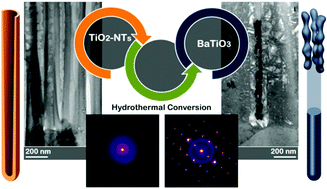Nanostructural evolution of one-dimensional BaTiO3 structures by hydrothermal conversion of vertically aligned TiO2 nanotubes†
Abstract
The use of TiO2 nanotube (NT) arrays as templates for hydrothermal conversion of one-dimensional barium titanate (BaTiO3) structures is considered a promising synthesis approach, even though the formation mechanisms are not yet fully understood. Herein we report a nanostructural study by means of XRD and (HR)TEM of high aspect ratio TiO2-NTs hydrothermally converted into BaTiO3. The nanostructure shows two different and well-defined regions: at the top the conversion involves complete dissolution of NTs and subsequent precipitation of BaTiO3 crystals by homogeneous nucleation, followed by the growth of dendritic structures by aggregation and oriented attachment mechanisms. Instead, at the bottom, the low liquid/solid ratio, due to the limited amount of Ba solution that infiltrates the NTs, leads to the rapid crystallization of such a solution into BaTiO3, thus allowing the NTs to act as a template for the formation of highly oriented one-dimensional nanostructures. The in-depth analysis of the structural transformations that take place during the formation of the rod-like arrays of BaTiO3 could help elucidate the conversion mechanism, thus paving the way for the optimization of the synthesis process in view of new applications in energy harvesting devices, where easy and low temperature processing, controlled composition, morphology and functional properties are required.



 Please wait while we load your content...
Please wait while we load your content...